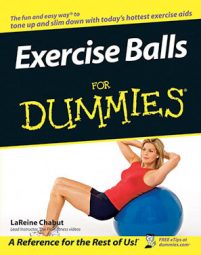When you begin using exercise balls in your fitness program, you’ll need to know how to warm up and position yourself on the ball before your workout.
Working out with an exercise ball requires a lot of endurance. As with any new form of exercise, avoid overtraining by resting 24 to 48 hours in between workouts.
Positioning yourself on the exercise ball
Training on an exercise ball has its own unique challenges. Because of its round surface, the ball is able to mold to your body or roll away in some cases. Here are a few important points to keep in mind:
Because some exercises on the ball require balance and coordination, starting out with the ball placed against a hard surface for support can help you gain confidence while you become acquainted with the exercises you'll be doing. Placing the ball against a wall or heavy couch may keep you from getting discouraged and give you a much better experience when you’re just starting out on the ball.
Just sitting on the ball is difficult because it’s an unstable base that requires strength in your back and abdominal muscles. If you sit on a chair or a weight bench at the gym, you certainly don’t use any of these muscles that you use when working out on the ball. By bringing your feet closer together when you’re sitting on the ball, you can intensify your workout by altering your base of support.
The farther away the ball is from your core (torso), the more difficult maintaining your balance is. For example, when you do a push-up on the ball, it’s much easier when you place the ball underneath your lower legs because it’s closer to your abs, hips, and glutes. To increase the difficulty, simply roll the ball out to your feet so that it’s farther away from the center of your body, making maintaining your balance harder.
Warming up before your exercise ball workout
You should always perform a warm-up before you begin your exercise ball workout. For a quick warm-up that gets the heart pumping, try a light five- to ten-minute workout of low-level cardio exercise to increase your body temperature and the flexibility of your muscles. Here are some suggestions for warming up the body:
Jump rope for five minutes
Get on a stationary bike for ten minutes
Walk on a treadmill for ten minutes at a slow to moderate pace
Walk outdoors, starting with a slow pace and working up to a faster pace
Swim for half a mile
Warming up your body increases the temperature of your muscles, which reduces the risk of injury.

